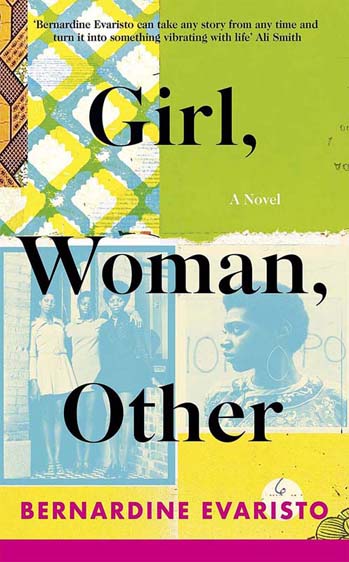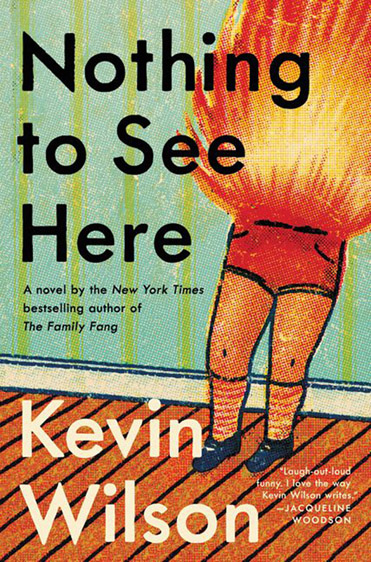-
March 12, 2020
Opening Round
-
Bernardine Evaristo
2Girl, Woman, Other
v.
3Nothing to See HereKevin Wilson
-
Judged by
Jenny G. Zhang
Engaging with fiction, by its very nature, requires a kind of negotiation with the act of believing. Colin Radford, in his 1975 article “How Can We Be Moved by the Fate of Anna Karenina?”, identifies the paradox of fiction, in which the following premises are presumably all true, but cannot be simultaneously so without contradiction:
- We are only genuinely moved by what we believe to be real; discovering that a presumably true pathos-soaked tale was a lie leads to a feeling of being duped.
- But no one who knowingly engages with fiction believes that those fictional characters or events are real.
- And yet fictional works and the non-realities presented within undisputedly move us.
The only way to square these contradictions, Radford concludes, is to admit that human beings are irrational creatures—not quite the neat explanation that some may be looking for. There are other possible solutions to the paradox, among them Samuel Taylor Coleridge’s idea of the “willing suspension of disbelief,” which involves the reader consciously believing in the illusion of the fiction so long while engaging with the fiction. The key here is consciously; rather than sit back passively, the reader must make an active effort to sustain the illusion.
J. R. R. Tolkien preferred a different mode; he espoused a state of secondary belief, in which the storyteller creates a secondary reality that works by its own consistent set of internal laws and logic, a world so convincing that the reader believes in it effortlessly. “The moment disbelief arises, the spell is broken; the magic, or rather art, has failed. You are then out in the Primary World again, looking at the little abortive Secondary World from outside,” Tolkien writes in his essay “On Fairy-Stories.” In other words, as some succinct soul puts it on the Tolkien fan portal Valar Guild: “The distinction here is between the conscious state of simply indulging the story, as it were, and the unconscious effect of being genuinely transported by art.” The latter, in Tolkien’s view, is what makes for an effective fairy story: You are transported, effortlessly.
Kevin Wilson’s Nothing to See Here is a kind of fairy story, as described by the author himself. It is, just as Wilson says, a bit like Mary Poppins—only instead of a nanny with weird powers and an enigmatic past, it’s the kids. The nanny, in this case, is Lillian, an aimless twentysomething who finds her life suddenly upended when she becomes the caretaker for an old friend’s twin stepchildren. It’s a role she’s objectively unqualified for, not least because of one tiny catch: The twins spontaneously burst into flames.
It’s a fantastical absurdity, even within the confines of the novel’s secondary world, which aside from the fire aberration closely resembles our actual contemporary one (Dolly Parton, political maneuvering, class differences, and all). Here, the kids’ uhh affliction is treated as a secret to be guarded and a danger to be confined—seems rational, given that they literally catch fire, but also reflective of the way disabilities are often treated in reality.
But the novel, for all its virtues—it’s warm and touching and delightfully spiky in many ways (“we rode in silence the rest of the way, the radio playing easy listening that made me want to slip into a hot bath and dream about killing everyone I knew,” narrates the sharply written Lillian early on)—can’t quite pull off the feat of secondary belief that Tolkien describes. The story asks a lot of the reader in leaving the stone that is the fire condition unturned. It’s true, not everything in life has an explanation, but when a child combusts in front of a slew of politicians and press, only for it to be smoothed over by an abundance of charm—I don’t know. I’m not entirely convinced. I felt the strain of making myself believe.
It felt easier to slip into the world of Bernardine Evaristo’s Girl, Woman, Other, and not just because that world is this world, told through the lives of 12 characters—most of them black women—in the UK, Girl, Woman, Other clearly has breadth, traversing across postcodes and lived experiences and the weight of a vast history, but there’s also a level of depth and interiority to the characters that is so impressive, considering the sheer number of viewpoints.
The book begins with Amma, a playwright whose opening night of her acclaimed production bookends the expansive narrative and introduces some of the names that resurface elsewhere. It took a little time to get used to both the writing style (as much poetry as prose) and the central character (frankly, Amma’s isn’t one of my favorite voices in this collective), but each subsequent shift took me deeper into the heart of the novel, constructing a web of interconnected stories that I didn’t even notice myself ensnared by until the silk threads were all spun.
While there’s little overarching storyline, there are themes abound to connect to: womanhood, blackness, love, sexuality, politics, ambition. Among them, I found the ideas of home and family—so fundamental to the roots and scattered spores of diaspora—especially emotionally resonant. One of the characters, Grace, loses her mother at a young age to tuberculosis (“she drowned on the liquid and tissue / sloshing about in her lungs while they ate themselves / from the inside out”). The girl dreams:
Grace rolled herself up in her blanket, buried herself deep inside is so they couldn’t hear how she felt when she thought of Ma
who’d wrapped her tightly in her arms while they slept
I’m never letting you go, Gracie, you’re mine
I looked up at my own mother seated near me, reunited for the holidays, and all I felt were swells of love and despair crashing violently into each other. She is nearly 60; how much longer until all I have left of her are memories and the feeling of her arms wrapped tight around me every time we say goodbye?
Girl, Woman, Other is not an escape, exactly, not in the same way that a dyed-in-the-wool Tolkien fairy story is. Rather, reading it feels more like choosing to burrow deeper into all that reality has to offer—the mundanities, the complexities, the pain and joy. That was my paradox: Rationally, I knew that these characters that moved me were fictional, but emotionally, the distance between our world and this secondary one collapsed, blurring the line between materiality and a truth more transcendent. It felt less like an abstraction and more like a certainty that these individuals and their stories exist, both within the book’s pages, and in some way, beyond. Maybe that’s just a delusion, another illustration of Radford’s conclusion that humans are simply irrational. But still, I’ll keep believing it.
Match Commentary
By Kati Stevens & Andrew Womack
Andrew Womack: In yesterday’s commentary I said Kevin and John would be back in the booth today, but I was so wrong! Instead, as we did yesterday, today we have another Reader Judge finalist here in the booth. This time it’s Kati Stevens!
Hello Kati, and welcome to the commentary booth! Before we dive into today’s judgment, can you tell us a bit about yourself and your experience with the Tournament of Books?
Kati Stevens: Sure. My day job is in the District of Columbia, where I employ your tax dollars in a desperate attempt to protect the environment, but by night I’m the author of Fake, a monograph in Bloomsbury’s Object Lessons series, about our relationship with objects we casually deem not real. As an avid follower of the Tournament of Books for some years now, I am stoked to be here. When I lived in China I had a rooster neighbor who had a predilection for 2:30 a.m. yodeling, and the only thing that kept me from committing bird-icide was imagining it was a distant relative of the rooster that some winner someday will actually accept as their rightful prize.
Andrew: Ah! This is absolutely true: After The Orphan Master’s Son won in 2013, Adam Johnson was open to accepting the live rooster, and we nearly got him one, but he eventually decided his neighbors would hate him if we were successful. Based on your anecdote, I’d say he made the correct choice.
For today’s judgment, I found the way Judge Zhang arrived at a verdict to be fascinating. The dilemma of how this fiction compares to that fiction is—of course—central to the Tournament of Books, and I appreciate how the decision was all about using suspension of disbelief as a yardstick in order to rationalize how each book measured up. Definitely a different kind of ToB judgment for sure—and it worked for me. What about you?
Kati: Initially I was surprised because for me certain aspects of Girl, Woman, Other strained credulity as well. I won’t spoil it for those who haven’t read the book, but we are gifted a bit of an abrupt aha moment at the end for one of the characters that we both see coming and is wildly unlikely. Still, happy endings are very rare in “serious” literature, and I appreciated that neither book shied away from them. Both of these novels enjoy torturing their characters, but at the end of the day they let them have wins, and, while I don’t sneer at a character arc that looks awfully like a rainbow, I think the realism of Girl, Woman, Other is a touch overstated.
I agree with Judge Zhang, though, that the world of Girl, Woman, Other is fully captivating. In fact, almost as soon as I started it, I was wishing for an Evaristo cover version of Nothing to See Here, because, despite the whole firestarter-children thing, Lillian and Madison, the children’s stepmother, have a very Girl, Woman, Other relationship. But if we can’t merge the two books together like some celebrity power couple, Zhang’s verdict is a solid plan B.
Andrew: As the author of Fake, can you tell us anything about believability as it relates to fiction?
Kati: Actually most of the conclusions I draw in my book aren’t really pertinent to fiction. Mostly I talk about why we consider certain objects “fake” and how our feelings toward those objects are shaped by cultural and socioeconomic norms. Only in stories and magic shows do we ask to be deceived and are angry if we are not fully tricked. For example, in one essay in my book I write about fake clothes and accessories. Say you purchase a “Balenchiagga” for $30 in Chinatown and then, a block later, realize it isn’t a real Balenciaga. Should you go back to yell at the person who sold it to you, you would be hard-pressed to find any passers-by to support you. Neither the purveyor of the $30 “Balenchiagga” nor the purse is trying to pull one over on you. Now spend $1,000 on a fake Balenciaga from a supposedly reputable seller, and you could have the person who sold it to you sent to prison—though they likely did a far better job as craftsman and liar.
Andrew: And how about how this might relate to today’s judgment?
Kati: Above Zhang wrote that Nothing to See Here lost her because she didn’t believe that people watching something impossible happen would accept a logical explanation from spin doctors over their eyes. I was more willing to take that leap. Research has shown time and again that our brains and eyes are not to be trusted. When we type a sentence and miss a word, our brain will often fill in the blank for us, and we will read it as if were there.
On the other hand, we have the Invisible Gorilla experiment, a research project conducted in the early 2000s by psychologists Christopher Chabris and Daniel Simons. They asked volunteers to watch a video where two groups of people—some dressed in white, some in black—were passing basketballs around, counting the passes among players dressed in white while ignoring the passes of those in black. Half of the volunteers were so focused on the assignment that they didn’t notice someone in a gorilla suit walk in and out of the scene. Trompe l’oeil and trompe le cerveau (I just made that second one up; apologies to our French friends) are always making us see—and believe in—things that are not there, and we often don’t see—or believe in—things that are right in front of our noses.
This is a long way of saying the reactions to a child suddenly catching fire in Nothing to See Here seemed well within the bounds of human behavior. But that’s one of the most fun things about reading. The more you learn about what and how people think, believe, and act, the more you realize: People are weird, man.
Andrew: How do you, personally, decide whether you like one book over another? Everyone’s different, of course, but do you feel it comes down to believability? Style? Something else?
Kati: I am definitely of the Daniel Kahneman school that often we just like a thing and then rationalize the why, but I think what my lizard brain most responds to is a clean structure
(Girl, Woman, Other’s punctuation-lite, tweet-like paragraphs—
Shirley
(not yet Mrs. King)
arrives at Peckham School for Boys and Girls
a former Victorian workhouse with two rectangular blocks of concrete attached incongruously to both ends of it
approached by what was once called the Paupers’ Path
leading up to its castle-sized doors
—were like ASMR for me, so satisfying) and a story that’s very visually detailed. The books I read last year that I most loved were The Children’s Hospital by Chris Adrian and The Map and the Territory by Michel Houellebecq. In both cases I felt like I was watching the story as much as I was reading it, and I had a similar experience for Nothing to See Here and parts, though not all, of Girl, Woman, Other. Is this taste for a more cinematic tale indicative of the screen zombieism now endemic to Western life? Would a shrug emoji be inappropriate in this forum?
Andrew: I consider it our second mascot! Thank you for joining us today, Kati.
Please, everyone, join us back here tomorrow, when The Water Dancer by Ta-Nehisi Coates meets Optic Nerve by María Gainza. Kevin and John will return to the commentary booth, unless they aren’t, in which case I’ll do what we’ve done the past couple of days and pick someone out of the audience so they can come up here and melt us off the stage.
New 2020 Tournament of Books merch is now available at the TMN Store. As a reminder, Sustaining Members receive 50 percent off everything in our store. To find out why we’re asking for your support and how you can become a Sustaining Member, please visit our Membership page. Thank you.
Welcome to the Commentariat
Population: You
To keep our comments section as inclusive as possible for the book-loving public, please follow the guidelines below. We reserve the right to delete inappropriate or abusive comments, such as ad hominem attacks. We ban users who repeatedly post inappropriate comments.
- Criticize ideas, not people. Divisiveness can be a result of debates over things we truly care about; err on the side of being generous. Let’s talk and debate and gnash our book-chewing teeth with love and respect for the Rooster community, judges, authors, commentators, and commenters alike.
- If you’re uninterested in a line of discussion from an individual user, you can privately block them within Disqus to hide their comments (though they’ll still see your posts).
- While it’s not required, you can use the Disqus
tag to hide book details that may spoil the reading experience for others, e.g., “ Dumbledore dies .” - We all feel passionately about fiction, but “you’re an idiot if you loved/hated this book that I hated/loved” isn't an argument—it’s just rude. Take a breath.



